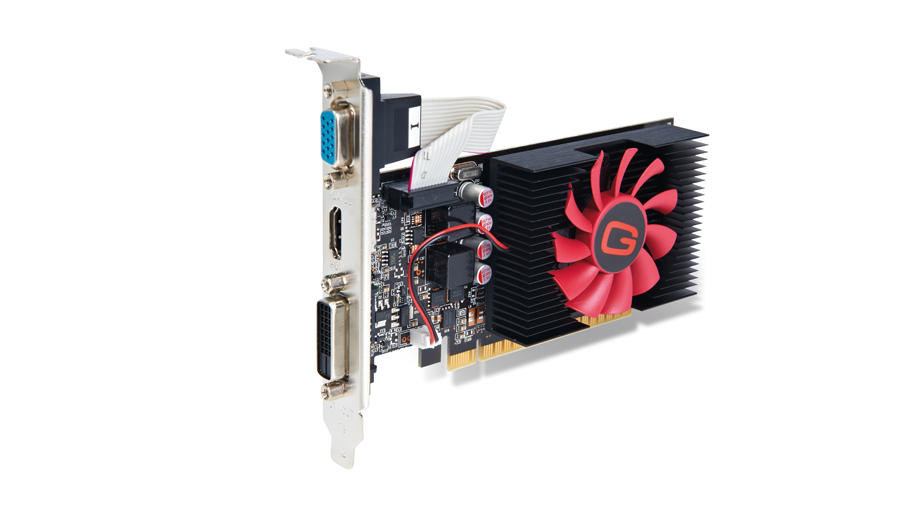TechRadar Verdict
Pros
- +
Good for small form factor gaming rigs
- +
Good gaming performance (at lower settings)
- +
Low power draw
Cons
- -
HD 7750 and HD 7770 offer better frame rates for not much more money
Why you can trust TechRadar
With this second revision of the GT 640 we seem to have entered a strange alternate dimension where everything is exactly the same, except instead of re-branding its old hardware with new names, Nvidia is updating the hardware in its graphics cards and keeping the name the same.
This version of the GT 640 is running with a new iteration of the Kepler GPU that first appeared in the latest 700 series mobile cards, and yet it's still holding onto the 600 series naming conventions.
And really this isn't the second revision either; if we're talking about GPU technology, then this is actually the third version of the card. We've already seen a Fermi-based iteration tip up before the two Kepler-powered GT 640s that appeared afterwards. That's not counting the ugly visage of the many DDR3-based versions, either. So yes, in all there have been five iterations of the GT 640, including this latest one.
What does this new GK 208 GPU get you? We're not talking about anything to do with actual gaming performance here because the GK 208 chip first appeared in mobile form so it's all about lower power demands and therefore has a chilled outlook on gaming. And that means it can be jammed into the sort of small form factor PCB Gainward has created for this card.
That's where the GT 640 stands apart from the likes of the two HD 7730s we've just taken a look at. We're talking similar graphical performance compared with the GDDR5 version and, inevitably, better performance than the DDR3 AMD card. And because it's knocking around the same price as both the HD 7730s, it has the same problems in terms of relative pricing.
The quicker HD 7750 and HD 7770 are only a shade more expensive, and both of them are much more capable of giving you a decent gaming setup at 1080p resolutions.
Benchmarks
These benchmarks were carried out at the highest 1080p settings with 4x AA, but drop the settings down a little and you'll easily top 30fps in most titles without much sacrifice.
Sign up for breaking news, reviews, opinion, top tech deals, and more.
The bonus of going Nvidia at this low level is the GeForce Experience software, which is a massive help when it comes to hitting playable framerates.
DirectX 11 1080p gaming performance
Bioshock Infinite: Frames per second: Higher is better
GT 640 REV 2: 17
HD 7730 1GB GDDR5: 15
HD 7750 1GB GDDR5: 20
DirectX 11 1080p gaming performance
Tomb Raider: Frames per second: Higher is better
GT 640 REV 2: 20
HD 7730 1GB GDDR5: 18
HD 7750 1GB GDDR5: 26
Peak platform power draw
100% GPU load: Watts: Lower is better
GT 640 REV 2: 91
HD 7730 1GB GDDR5: 118
HD 7750 1GB GDDR5: 116
Half a pint
The GT 640 does have its versatility to fall back on. The half-height PCB makes it a rather effective discrete GPU to match with a low-profile, small form factor PC. While we're seeing more mini-ITX chassis capable of housing full-scale graphics cards, it's still good to see some graphical loving going to the half-pint cases, too.
I was impressed by the cooling array on the wee card as well. Although the heatsink is chunky, I was expecting the small fan to end up being a bit of a whiner, but it's almost silent in operation. Thanks to the lower power GPU and that cooling setup, even at full load this card is only hitting around 54ºC at max.
For a relatively cheap, teeny and quiet discrete card that's capable of acceptable gaming performance (once you knock the settings down a notch or two) the GT 640 is a pretty impressive thing.
I'd still only recommend it for a chassis that needs a half height PCB (although, strangely, Gainward doesn't supply a smaller bracket in the package) because something like a HD 7770 is much more of a gamer card in the sub-£100 market. It's not bad for diminutive rigs, though.
